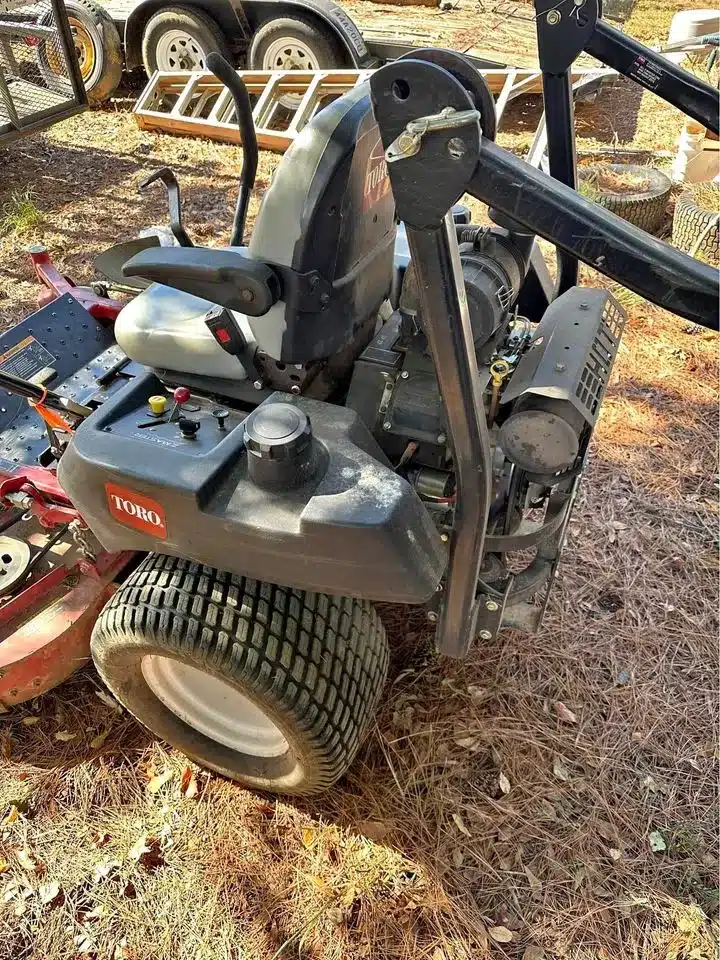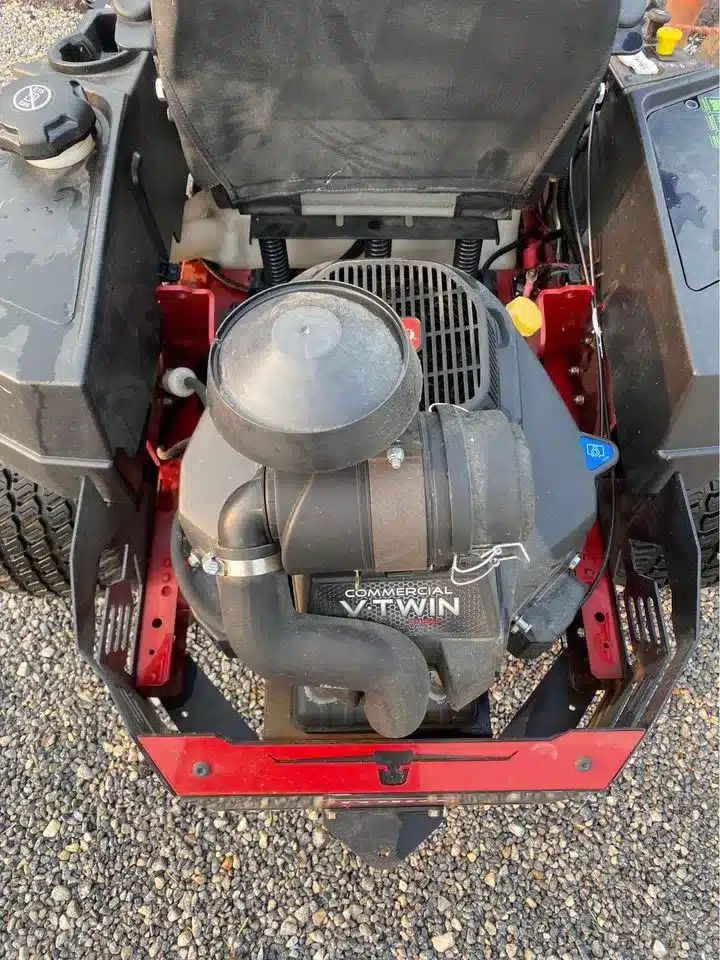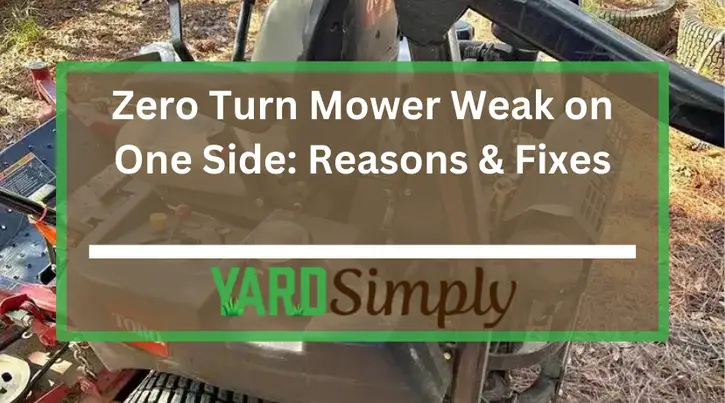Drawing from years of hands-on experience with lawn maintenance equipment, I bring to the table a comprehensive understanding of zero-turn mowers.
When you’re encountering a zero turn mower that’s weak on one side, you’re facing a common but solvable issue.
My technical expertise has equipped me to identify and address the root causes of this problem, from routine maintenance oversights to more intricate mechanical failures.
This article is designed to offer you practical solutions and preventative measures to restore balance to your mower’s performance, ensuring a pristine and uniform lawn.
Trust in my guidance as we tackle the nuances of a seemingly lopsided zero-turn mower together.
Key Takeaways
- Troubleshooting a zero-turn mower weak on one side involves checking components like tire pressure, the freewheeling rod, and the hydrostatic system for faults.
- Regular maintenance, including belt, brake, and blade inspections, is crucial for preventing and resolving power imbalances in zero-turn mowers.
- Approximately 80% of issues with zero-turn mowers can be resolved through routine maintenance and part replacements.
- Based on my experience, the agility and efficiency of zero-turn mowers outweigh the occasional challenges in troubleshooting side weakness.
Overview of Possible Reasons and Corresponding Fixes
My zero turn mower’s reduced power on one side can often be attributed to a few common issues, which I’ll identify along with their respective solutions.
First, the problem might stem from the hydraulic motors. They’re the heart of the mower’s hydrostatic drive system.
If there’s uneven power, one motor may fail or leak. I’d check for leaks and consider having a professional inspect or replace the motor if that’s the case.
Another culprit could be the drive belt. If it’s worn or has slipped off, then it’ll cause a loss of tension and, consequently, a reduction in power.
I’d look over the belt for any signs of wear or damage. If it’s just slipped, I’d reposition it; if it’s damaged, I’d replace it.
Lastly, the idler pulley could be at fault. It maintains proper tension on the belt, and if it’s malfunctioning, that tension can be compromised. I’d inspect the pulley for wear and ensure it’s functioning correctly. If it’s not, I’d replace it.
Here is a closer look at the specific topics covered, each addressing a different aspect of the mower’s mechanics and maintenance:
- Discrepancy in Tire Pressure Across Different Sides
- Impact of Engaged Freewheeling Rod
- Stuck Brake
- Worn Spline
- Fine-Tuning Traction Control
- Effects of Worn or Aged Dampers
- Hydrostatic Motor Air Pressure Variances
- Complications Related to the Deck Belt
- Issues with Dull or Damaged Blades
Discrepancy in Tire Pressure Across Different Sides

I’ve noticed that uneven tire pressure can cause a zero turn mower to perform poorly on one side.
It’s crucial to check and adjust the tires regularly to ensure they’ve equal pressure.
If one side is weaker, it might just be a simple fix of evening out the tire pressure.
Solution
Ensure both tires are inflated to the manufacturer’s recommended PSI. This is a fundamental step because the hydrostatic system in zero turn mowers heavily relies on balanced tire pressure to operate effectively.
If there’s a significant discrepancy, the lawn mower may veer off course or exhibit reduced efficiency on one side.
Impact of Engaged Freewheeling Rod
When your zero turn mower was lagging on one side, you checked the freewheeling rod, suspecting it was engaged.
This rod, when engaged, disengages the hydrostatic transmission, allowing manual movement of the mower but can cause uneven power distribution if left in the freewheel position.
Ensuring the rod is properly positioned is crucial for balanced and effective mower operation.
Solution
When I first noticed my mower dragging, I was puzzled. The wheel on one side just wasn’t keeping up, making my lawn care routine more of a chore than a breeze. After some troubleshooting, I realized the engine wasn’t the culprit.
Instead, the engaged freewheeling rod was preventing my mower from delivering equal power to both wheels. Once I disengaged it, the power balance was restored. It’s a simple fix, but it made a world of difference.
Stuck Brake
I’ve noticed my zero turn mower isn’t performing evenly; it seems weaker on one side, which could indicate a stuck brake.
I’ll need to inspect the braking system to confirm this suspicion and find a solution.
If that’s the issue, fixing the stuck brake should restore my mower’s full functionality.
Solution
Locate the problematic caliper and inspect the brake assembly. The piston could not be retracted properly, causing constant pressure on the disc.
Carefully cleaned around the piston and caliper, removing any debris that might’ve caused the jam. After that, use a pressure gauge to ensure the hydraulic pressure is within the specified range for the brake system.
Worn Spline

I’ve noticed that a worn spline can significantly affect my zero turn mower’s performance, particularly on one side.
Inspecting the drive shaft for any signs of wear or damage that could be causing the issue is important.
I’ll now look into a viable solution to address this problem and restore the mower’s full functionality.
Solution
To address the issue, I knew I’d to replace the damaged spline to restore the mower’s performance. I made sure the mower was off and the throttle was in the neutral position before I started.
Carefully, I removed the wheel to access the spline connected to the motor. Once I located the worn spline, I replaced it with a new one, ensuring it was securely attached to the wheel motor and pulley system.
I also checked the other side to prevent future imbalances.
Fine-Tuning Traction Control
I’ve noticed that when my zero turn mower starts pulling to one side, it’s often a traction control issue that needs adjusting.
I’ll explain how fine-tuning your mower’s traction can solve this annoying problem.
It’s a straightforward fix that can restore your mower’s balance and efficiency.
Solution
If you observe that one side of your mower is slipping, it might indicate a need for traction adjustment. It’s important to refer to your mower’s user manual for model-specific instructions.
The adjustment process can be complex, so consider seeking professional help if you’re unsure.
Based on personal experience, a tip to enhance traction is to slightly lower the tire pressure.
Additionally, if you often mow on slopes, upgrading to larger tires could be beneficial. Larger tires help in making smoother turns and reducing sudden stops on uneven terrain.
Effects of Worn or Aged Dampers
I’ve noticed that when my zero turn mower starts pulling to one side, it’s often due to the dampers wearing out. These crucial components can lose their effectiveness over time, leading to uneven control and reduced maneuverability.
I’ll explore how replacing old dampers can be a straightforward solution to this problem.
Solution
I’d noticed the issue during mowing sessions when one side seemed to lag, creating uneven cuts and adding time to my lawn care routine.
This drag not only made the task more laborious but also put extra strain on the functioning side, potentially leading to more wear and tear.
After some research, I learned that dampers are crucial for maintaining the blade’s torque and stability. The mower’s responsiveness improved dramatically once I swapped out the aged dampers for new ones.
Now, it glides evenly across the grass, and I can manage my lawn without the added hassle and inconsistency.
Hydrostatic Motor Air Pressure Variances
I’ve noticed that inconsistencies in hydrostatic motor air pressure can lead to one side of a zero turn mower performing weaker than the other.
It’s essential to understand that proper air pressure is critical for balanced operation and maneuverability.
Let’s explore how addressing air pressure variances might be the solution to this issue.
Solution
I’ll examine the hydrostatic system, focusing on the pistons and dampers. These components are vital for smooth control and power distribution.
If there’s air trapped in the system, it can cause imbalances, so I’ll bleed the air according to the manufacturer’s instructions.
Learn More: How to Change Hydraulic Fluid in Zero Turn Mower: Guide
Complications Related to the Deck Belt
I’ve noticed that a worn or damaged deck belt can cause my zero turn mower to lose power on one side.
It’s essential to inspect the belt for signs of wear or tear, which can prevent the blades from turning efficiently.
If the deck belt is the culprit, replacing it’s often a straightforward fix to restore full function.
Solution
Deck belt inspection is my first step when tackling the issue of a zero turn mower that’s weak on one side. I check for any signs of wear or corrosion that could indicate a need for replacement.
If the belt’s fine, I’ll turn my attention to the mower’s throttle. It’s crucial that the throttle is set correctly to maintain balanced pressures and power distribution.
Related Posts:
- How to Adjust Mower Deck on Husqvarna Zero Turn Mower
- Bad Boy Mower Deck Adjustment: Instructions and Useful Tips
Issues with Dull or Damaged Blades
I’ve noticed my zero turn mower isn’t cutting as evenly as it should. This could point to an issue with the blades. If they’re dull or damaged, they won’t slice through grass cleanly, leading to a weaker performance on one side.
Let’s explore how sharpening or replacing the blades can be a solution to this problem.
Solution
Why should I overlook the simplicity of sharpening or replacing the mower blades when it could be the straightforward fix my zero turn mower needs to resolve its lackluster performance on one side?
It’s not just about the blades cutting grass; dull blades can strain the mower, causing one side to seem weaker. If the blades aren’t slicing through grass and creating a clean mulch, then it’s time to take action.
I’ll inspect the blades for damage and sharpen or replace them as needed. I’ll also ensure that other components, like the drum brakes, throttle, and handlebar controls, are functioning properly.
Our Verdict
In my journey with zero turn mowers, I’ve realized that tackling a mower favoring one side is part of the adventure.
Whether it’s balancing tire pressure, swapping out a worn spline, or simply disengaging that sneaky freewheeling rod, each fix has been a learning experience.
I’ve found that regular maintenance, like checking the blades and keeping an eye on the hydrostatic system, really does wonders.
Sure, it might seem daunting at first, especially if you’re not mechanically inclined, but trust me, the satisfaction of smoothing out those quirks is worth it.
And let’s be honest, nothing beats the pride of a well-manicured lawn, thanks to a well-tuned mower. So, from my experience, a little patience and some elbow grease go a long way in keeping your favorite zero turn mower running like a dream.
Frequently Asked Questions
How does regular maintenance affect the longevity and performance of a zero turn mower’s steering and propulsion systems?
Regular maintenance keeps my mower’s steering and propulsion in top shape, extending its life and ensuring it performs well. Without it, I’d likely face more breakdowns and uneven lawn cuts.
Can uneven weight distribution on the mower, such as a heavier attachment or rider weight bias, cause one side to become weaker over time?
Yes, uneven weight distribution can lead to one side weakening over time. If I’m consistently adding more weight to one side, it’ll likely wear down faster and affect the mower’s performance.
Are there specific brands or models of zero turn mowers that are more prone to experiencing weakness on one side, and if so, which ones?
I’m not aware of specific brands more prone to this issue. It likely depends on design and maintenance rather than the brand. I’d suggest checking reviews for any model you’re considering.
What safety precautions should be taken when attempting to diagnose and repair a zero turn mower that is weak on one side, especially for individuals without mechanical experience?
I’ll ensure the mower is off and keys removed before inspecting. Wearing protective gloves and eyewear is crucial, and I won’t attempt repairs beyond my skill level to avoid injury.
How does the terrain or type of grass being mowed influence the likelihood of one side of the zero turn mower becoming weaker, and are there different considerations for commercial versus residential use?
I’ve found that mowing on uneven terrain or thick grass strains my mower more, which could lead to uneven wear. Commercial mowers might handle this better than residential ones due to their robust build.


